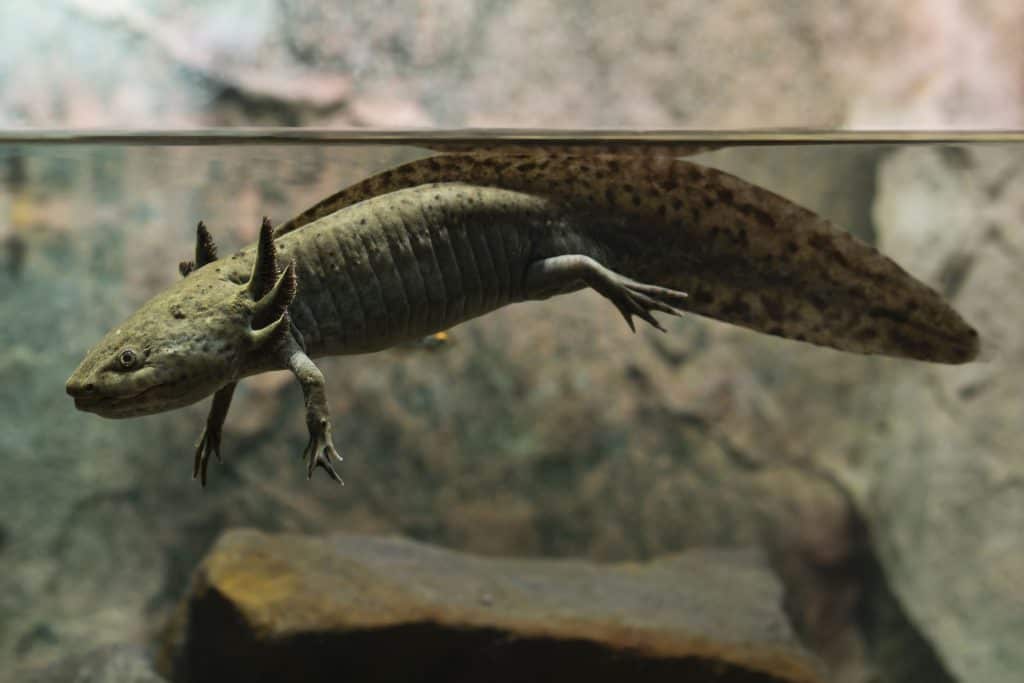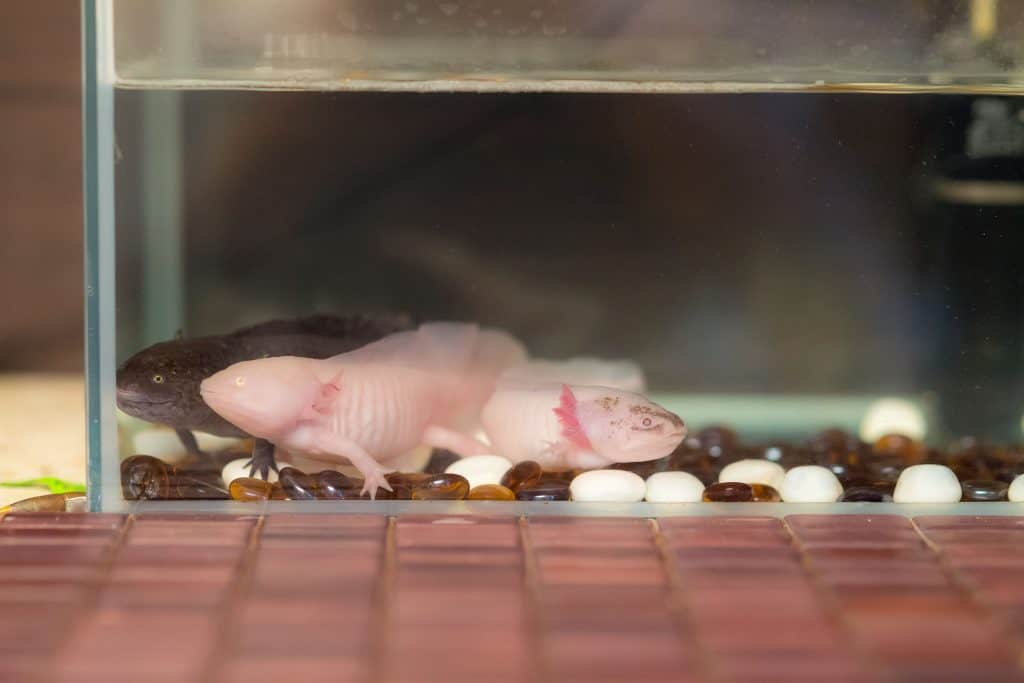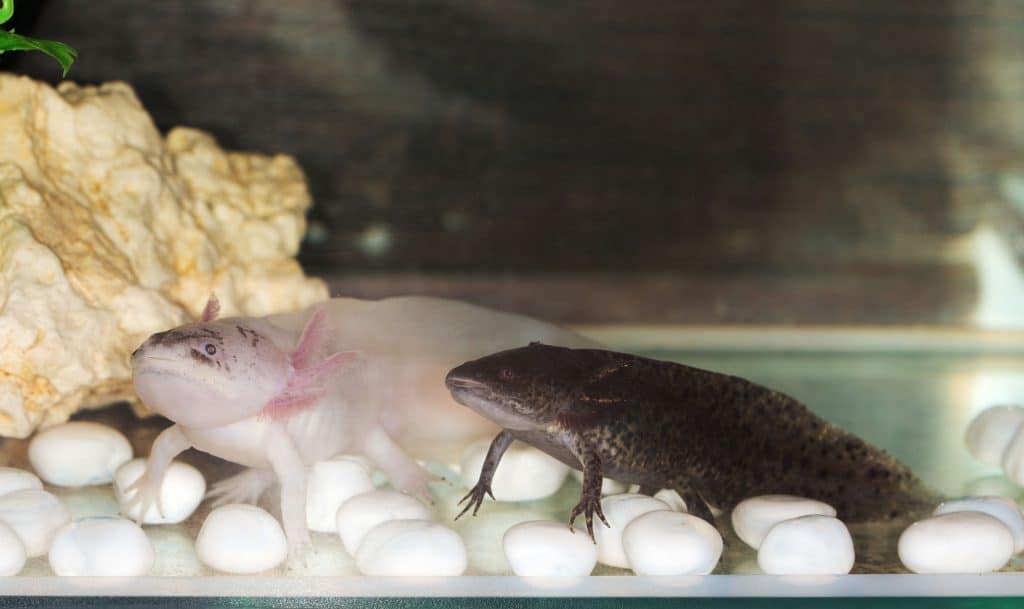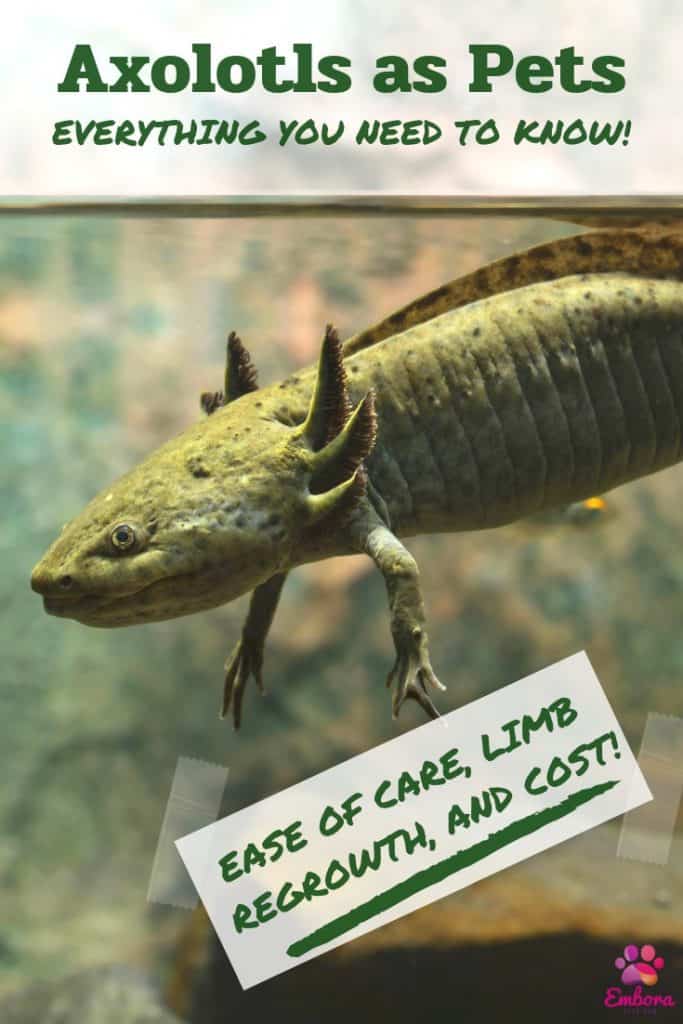Axolotls as Pets: Cost to Get One, Ease of Care, and Limb Regrowth
When you’re on the lookout for a new pet, you may have stumbled upon the unique creature, the Axolotl. This creature, while adorable, can be strange and somewhat difficult to care for. New owners might need information on this unique animal.
So, how does an Axolotl work as a pet?
Axolotls make for great pets, due to their easily manageable lifestyles and low costs. Axolotls generally cost between $20 and $70, with lower prices for the younger axolotls. They are confined to a tank, so all their care is generally centered on tank living. As an extra perk, they can regrow their limbs!
Axolotls are complex creatures, so I’ll break down what exactly you’ll need to know about the cost of one, how to care for an axolotl, and how the axolotl’s limb regrowing powers operate. Buckle up as we dive into the world of keeping an Axolotl as a pet.
Costs of Owning an Axolotl
The first thing that you’ll need to consider are the financials of owning the pet. Axolotls are relatively cheap compared to most other animals. Their diet is diverse which leads to an ease of access to food for the axolotl.
Since the Axolotl is aquatic your upkeep of the animal is all based in the tank. So once you have a method of keeping the tank clean you should be able to maintain that state for the axolotl’s home.
The upfront price of owning an axolotl is about $250 on average.
Finally, the axolotl doesn’t have as many accessories as other animals but there are plenty of extra fun items that can be added to the axolotl tank in the same way they could have been given to a fish in their fishbowl.
These items can be found on sites like Amazon and will need to fit the dimensions and capabilities of the setup that you have for your Axolotl.
Price of an Axolotl (About $30)
We are talking about the price of the pet itself here. Axolotls, similar to other amphibians and reptiles, have a different cost based on their color.
For instance, the wild color of Axolotl (darker with lights patches) will likely be attained at $20. However, a juvenile white-colored Lucy axolotl will cost about $28.
There are a couple of general rules when shopping for axolotls. First, the rarity of the axolotl type will affect the price it is being sold at.
For instance, the Chimera axolotl only has a 1 in 10,000 chance of appearing. As a result, those axolotls are incredibly expensive and rarely attainable.
Second, juveniles cost less than adults. This one is based on how much effort the consumer is going to put into their pet. Juveniles take a lot more work for you to take care of. Not to mention it will take more of your time to have a young axolotl than to have an adult axolotl.
With this in mind, the following chart shows some prices for the axolotls based on their rarity.
| Wild Type Axolotl | $20 to $30 |
| Lucy Axolotl | $28 to $35 |
| Gold Albino Axolotl | $25 to $35 |
| White Albino Axolotl | $20 to $40 |
| Green Floresent Protein Axolotl | ~$70 |
| Copper Axolotl | ~$85 |
| Rare Axoltols | Based on Seller |
For more information on prices, check with your local exotic pet store owners or check out websites like buy.axolots.com.
Price of Axolotl Necessities (About $220)

Of course, it is not only the cost of the pet but all of the materials that require that pet’s upkeep that needs to be planned for. These necessities fall into a couple of categories.
Food (About $20)
Axolotls have quite the array of food that they’ll munch on. As such there are quite a few food options that you can provide for your axolotl. Among the best options available you can get.
- Worms
- Snails
- Crustaceans
- Small Fish
- Brine Shrimp
- Salmon Fish Pellets
From the food options above the cheapest options are the salmon fish pellets and worms both of which are available in bulk sizes. Small fish are a very convenient way to feed the axolotl, as long as they aren’t large enough to bit the axolotl, as the axolotl will eat the food whenever it is hungry.
Food will cost anywhere from $5 to $30 dependent on type and quantity.
You can use this if you are leaving on a trip of some kind so that the Axolotl can feed itself.
One quick word of caution here, don’t feed your Axolotl worms or fish that you have caught yourself. They may contain parasites or viruses that can be transferred to your Axolotl.
Filter (About $100)
The largest expenses for the axolotl fall under the filter category. As we will talk about in the caring for your axolotl section axolotls are very sensitive creatures, as a result, you will need to maintain an exact chemical balance in the water. You’ll want to try to keep to the following figures.
Filter equipment will cost anywhere from $40 to $200.
- Acceptable PH levels: 6.5 to around 8.0
- Ideal PH levels: 7.4 to 7.6
- Ammonia Levels: 0ppm (Anything over 1ppm can kill your axolotl)
- Nitrite level: 0ppm (Same as ammonia, 1ppm or more is deadly)
- Nitrate levels: 2ppm to 40ppm (anything higher is toxic. 20% water changes to stop this level rising to toxic levels)
For more information on the correct filter, chemical measuring tools, and other filter based resources check out this link.
Tank (About $100)
Axolotls need to have a 20-gallon tank. Those usually aren’t that expensive but you’ll also need some plants, a tank cover of some kind, and substrate or flooring to fill up your axolotl’s home.
In total, this will cost around $100.
Tank covers are especially important as an Axolotl will jump out of its tank when scared, so if you are not cautious it may jump from its tank causing issues to arise as axolotls need to stay in water to protect itself.
Caring for Your Axolotl
Axolotls are very sensitive creatures, things like too much light, strong water currents, warm water, and an imbalance of chemicals within water can cause them undue amounts of stress and can even lean to harming them.
Caring for an axolotl is initially very difficult, as you have to find the means to meet all the required standards but after meeting those standards maintaining them should be easy.
The Right Tank for an Axolotl
When it comes to the right tank there are so many different details that need to be met. Think about it. In our homes, how much furniture, food, and entertainment do we have around? A lot, right?
Well, your axolotl doesn’t need all that much in comparison, but he needs some things to keep himself occupied.
Size
Axolotls at a minimum need a tank that can hold ten gallons. The optimal tank size in twenty gallons, though. The reason for this is that Axolotls dispense a lot more waste than a fish might, they are bigger than most fish after all, and that excess waste will fill up a tank quite fast so the large the tank the less you’ll need to be fishing out feces.
Having a large size tank also allows the axolotl more freedom. Looking at minimum requirements again you only need to fill the tank up enough to cover the axolotl if it was standing straight up lengthwise.
This generally will be about 10 inches to a foot of water. However, I give my Axolotl about half a foot extra that way he has more room to travel in.
If the tank for your axolotl is going to be shared by other axolotls you will want the tank size to increase by 20 gallons for each axolotl. This should give them plenty of room to have space to themselves if they so wish.
Gravel
The gravel or substrate that you use to cover the bottom of the tank is very important. You have two options make sure it is a fine material like sand that will be used as a substrate or that it is large rocks used as a form of gravel.
The difficulty with small pebbles is that Axolotls will eat small pebbles and this will block their digestive tract. This is incredibly dangerous to the axolotl and actually, leads to one of the most common health issues within axolotls. So avoid the pebbles and either go really small or large.
Some people avoid using gravel or substrate whatsoever. While this is preferable to using small pebbles that is pretty much the only situation that it is preferable to having no flooring in a tank.
Axolotls need the flooring to have some grip to crawl across the ground.
When it is just the glass bottom of the tank this can frustrate and stress out the Axolotl. To avoid this add substrate or large stones to help the Axolotl’s movement.
Filter
Next, let us talk about the filter. Any tank-bound creature is going to need a good filter. If you don’t have one then you’ll need to clean the water out by hand which means a lot of frequent replacing of the water within your axolotl’s tank. This gets monotonous and is rather easily avoidable with a filter.
Filters can range in expense though you can find some for $15 and other for $165. One type of filter you can go with is the box or corner filter. These are the classic inside of the tank mechanical filters.
They do a good job both regulating the chemicals in the water as well as keeping the water clean.
You’ll need to be careful in picking these filters though as filters with strong suction may pull at the extremities of the axolotl causing some appendages to be pulled off.
Alternatively, you can go with sponge filters which provide good mechanical and biological filtration however its chemical filtration can leave something to be desired for the specification of an axolotl.
If you go with a sponge filter you may just want to test your tanks water to see if it is reducing the chemicals enough for your axolotl.
Axolotls and Shared Living Spaces

When it comes to axolotls living with other creatures, it is generally not advised. If any creature is going to live with an
Axolotls are at the top of the food chain in their natural environment this means that pretty much anything that you put into the tank will either be eaten by the axolotl or will attack the axolotl.
Either way, it’s not a happily shared space, unless you want the axolotl to eat what you placed inside such as small fish as mentioned above.
This danger can extend to a shared space between two axolotls, as axolotls, especially young axolotls, have cannibalistic tendencies.
It is best to wait until after they are about five inches long to put them in a tank with each other and even then you will want to keep watch to ensure your axolotls are over such tendencies.
Axolotl Need-to-Knows
Lifespan of an Axolotl
Axolotls are fairly long-lived pets. They can live up to twenty years and live to a standard of 10 years of age. This combined with their regenerative abilities allows for the axolotl to live generally
An axolotl’s life span can be shortened if it is consistently facing stress from elements of its environment that it does not find pleasing. With this in mind minimize the stress on the axolotl and it should live a longer life.
Other factors such as whether the axolotl eats things it’s not supposed to, like pebbles, can lead to strain on the axolotl’s body and further shortening of the axolotl’s life if it doesn’t die from the improper eating directly.
Axolotl Temperament
Axolotls are calm and well-mannered creatures so much so they are the oldest recorded captive creatures that we have used for lab experiments and such. The reason for this is the axolotl’s temperament.
As long as the environment they are used to is replicated they don’t require much else besides food.
This on top of the elements of the regenerative abilities of the axolotl that are so famous makes it one of the most experimented-on creatures in the world.
Axolotl Breeding
Axolotls reach sexual maturity at around a year of age though since some axolotls are late bloomers you may want to wait until the 18-month point before making any attempts at breeding.
A male axolotl will initiate breeding by asking the female axolotl by nudging its head to the female’s hindquarters.
From which if the female accepts the axolotls will perform a mating dance wherein the male will drop spermatophores on different terrain around the area. The female will follow picking up the spermatophores with cloaca.
These spermatophores are then stored inside the female’s spermatheca. After this mating dance, the female will likely lay eggs with 12 to 20 hours.
Axolotls lay between 100 and 1000 eggs on the leaves (though 200 to 600 is most common). After about two weeks, they hatch. At this point, they remain in this larvae tadpole state for another two weeks. At this point, they leave in search of food.
It is important for you to separate the parents from the kids at this point as the parents will eat their children. As the children grow older they will also develop cannibalistic tendencies so you’ll want to separate them when they start showing signs of that behavior.
Axolotls have about a 97% infant mortality rate. So while many eggs are laid very few will be born out of the eggs. You will get about 30 survivors out of a full hatch of 1000.
To learn more of the specifics about how to breed certain axolotls, as well as more details on the breeding process, check out ExoPetGuide’s article on it.
Common Causes of Axolotl Health Problems
Axolotls are durable creatures after they have made it into adulthood. Part of this comes from their regenerative abilities, but it also comes from them being the top of the food chain in their natural environment.
Despite these large benefits to their survival, there are still a few common causes of health problems that appear in axolotls.
Nutritional Problems/Fluid Problems: The leading source of this problem is poor chemical content within the axolotl’s tank. First, take the axolotl out of the tank and place them in water that meets the required specifications of the axolotls.
Then test the water of the other tank. Often times you’ll find too much nitrate or ammonia, both of which shouldn’t be in the tank at all. Or the PH of the tank is too high or low, keep it from 7.0 to 8.0.
Wounds
The big issue here comes from infection. Axolotls can regrow their limbs and don’t bleed very much, so it rarely has issues with blood loss.
However, if the axolotl gets infected while the wound is still open, then it will have a problem, especially as that infection will be sealed within the axolotl’s body. Due to its regenerative ability, it can be harder to remove the infected area.
To combat this the best method it keeping your axolotl’s tank clean and removing anything that could cut or tear at your axolotl. This includes strong water filters, the edges of terrain within the aquarium, and other occupants of your axolotl’s tank.
Bacteria, Fungus, Parasites
These are either born from poor tank maintenance or brought into the tank from the food that you are giving to the axolotl. Regulate this issue through thoroughly cleaning your axolotl’s living space as well as regulating the food that you give them.
Don’t give an axolotl food you caught!
This is particularly important for small fish and worms. Don’t give an axolotl food you caught.
Care Summary

Axolotls are used to one specific environment and they aren’t very adaptable to new environments. You are required to keep your tank as close to the environment that axolotl prefers or else it will start to stress or face harm.
However, axolotls’ temperaments are some of the best out there for a creature. They are interactive and don’t require much maintenance, besides tank cleaning and feeding.
So look toward the axolotl if you are ready to set up an environment for it and want a creature that can smile your sorrows away.
For a more in-depth guide on all the specifics of caring for an axolotl check out this comprehensive care guide.
Limb Regrowth
When axolotls are brought up in conversation there are two things that generally spring up in the conversation: their adorable smile/yawn or their amazing regenerative ability.
The regenerative ability of axolotls is insanely complicated and awe-inspiringly cool.
So, let’s break it down. What can it do? How does it work? And why is it important?
What Can an Axolotl’s Regeneration do?
Let’s start by looking at what an axolotl can regenerate. Simply put a lot, there is very little that an axolotl can’t regenerate so long as it has the time to do so. That said here are some of its most significant regeneration achievements.
- Limbs
- Brain
- Jaw
- Spine
- Heart
When I said almost anything, I meant it. These wounds are sealed off quickly and each works as if they had not been wounded in the first place.
Is there a limit to how many times this works, though? Can axolotls only grow their arms back eight times? It’s like the whole nine lives limit cats supposedly have, right?
“You can cut the spinal cord, crush it, remove a segment, and it will regenerate. You can cut the limbs at any level – the wrist, the elbow, the upper arm – and it will regenerate, and it’s perfect.
There is nothing missing, there’s no scarring on the skin at the site of amputation, every tissue is replaced. They can regenerate the same limb 50, 60, 100 times. And every time: perfect.”
Professor Stephane Roy
of the University of Montreal
What about the duration? Does it take awhile for these incredible creatures to regrow these limbs?
On average, it takes the axolotl 40 to 50 days to regrow a limb. It may take longer due to the size of the limb it needs to regenerate. As axolotls grow older, they get bigger. This means regenerating that limb will take longer. However, the limb is always grown back to the appropriate size for the axolotl’s body.
How Does an Axolotl’s Regeneration Work?
The regenerative process is incredibly complicated so I am vastly oversimplifying it here. However, as a quick overview:
- A wound is made.
- Epidermal cells then form a wound epidermis.
- Cells in wound epidermis multiply forming the blastema.
- The blastema flattens and stretches to the correct size.
- Cells differentiate, the limb becomes indistinguishable from the body.
Step One-At the time of injury, very little blood is released, as the axolotl’s body is immediately thrust into its repairing process.
Step Two-Cells from throughout the body convert to undifferentiated cells and then form a wound epidermis.
Step Three-These cells begin to rapidly multiply, so much so that the blastema is formed. This is a cone-shaped collection of these undifferentiated cells.
Step Four- The multiplied cells stretch to match the size of the axolotl’s body flattening from the original cone-like structure it was originally in.
Step Five-Finally, the undifferentiated cells turn back into the cells they once were and the limb function perfectly.
This is a large oversimplification of a very complicated process so if you are interested in further exploring this topic check out my other article on specifically the regenerative abilities of the Axolotl.
Why is Axolotl Regeneration Important?
Imagine if we could harness the regenerative power of the axolotl. Amputees, burn victims, even cancer patients could have their pains removed from them. The study of axolotl’s and their regeneration has been done for just this reason.
To clarify, this isn’t just a set of recent studies that scientists have recently looked into. You should know that axolotls are known as being the oldest recorded lab animals.
This is partially due to their calm demeanor, but also because of the many mysteries that still have yet to be unfolded about the axolotl’s regeneration.
The study of axolotls has already proven some results as, through the efforts of starting to decode the axolotl’s genome, we have found that there is a strong correlation between the macrophages of an axolotl’s immune system and it’s regenerative ability.
This causation was made apparent when scientists suppressed the macrophages within the axolotl it could not grow back limbs that had been cut off. Instead, they formed scar tissue in the area, similar to how a
Related Questions
Is it legal to own a pet axolotl?
You can own a pet axolotl in most states. The exceptions to this rule are California, Maine, New Jersey, and Virginia. New Mexico, on the other hand, does not allow axolotls to be imported into the state. These restrictions are due to fear of a released creature harming the environment.
What pets are similar to the axolotl?
If you’re not sure about an axolotl, you have plenty of other similar options in the reptile and amphibian categories. Two popular similar creatures to the axolotl are the gecko and the chameleon.

